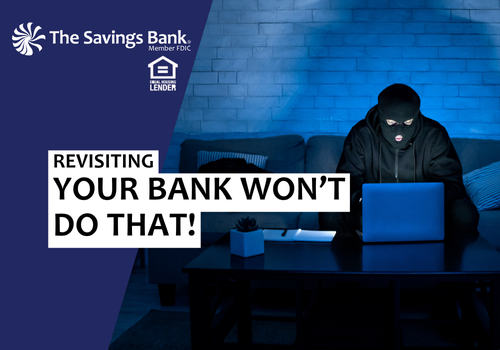Revisiting Your Bank Won't Do That!
06/18/2025

Revisiting Your Bank Won’t Do That!
Bank impersonation scams cost consumers millions, with the average person losing $3,000 to the scammer as well as being at risk for identity theft (FTC.gov). These scams are a specific sub-set of the impersonation scam where a criminal attempts to gain trust and access to accounts by spoofing bank communications. Let’s look at some things your bank would never do.
Consumer losses due to text impersonation scams skyrocketed to $330 million in 2022 (FTC.gov) and show no signs of slowing down. Most of these scams were criminals impersonating a bank. Their main goal is to gain access to personal information like Social Security numbers, credit card or debit card numbers, or bank login credentials. Knowledge is power, so knowing how to spot impersonators can save you from the headache of a scam.
Your bank will NOT:
- Text you and ask you to follow a link to secure your account.
- Ask you to provide your full login credentials or ask you to login via a link.
- Email you about a potential breach in security and ask you to follow a link to login and unfreeze your account.
- Call you and ask you to provide full account numbers, social security numbers, PINs, or login credentials.
- Send an unsolicited email with an attachment.
- Send a text via a traditional ten-digit phone number (legitimate communications from your bank via text come from a 4-5 digit “short code” that is usually the same every time).
- Threaten you via email, phone call, text, or direct message.
- Ask you to send money to yourself or move your money from an account that does not have your name on it.
- Try to get you to act by creating a sense of urgency.
Some of this may seem a little confusing, so here are a couple of examples you may see from scammers.
Case Study #1
You receive a text from 1-800-555-5555 that says, “This is you’re bank! Please login immediately using the provided link to secure your account.” You hover over the link destination and see it goes to a similar, but different website than usual.
Why this is a scam: The immediate red flag should be that the text came from a ten-digit number that is not the usual one your bank uses for text communications. The other issues are that there are spelling mistakes (you’re rather than your), they are asking you to click a link to login, and they are asking for your full login credentials. Also be aware that criminals spoof websites of legitimate banks. It is important to pay attention to the details of the URL, such as if the linked website is a .COM and not a .BANK. You can also verify the URL of FDIC insured banks at the FTC website here: https://banks.data.fdic.gov/bankfind-suite/bankfind.
Case Study #2
You receive an email that contains an attachment and the following message, “Your account has been hacked. Please open the attachment and follow the instructions to unfreeze your account.” You open the attachment to find a different number than the one you usually use to contact your bank and unfamiliar directions on how to get access to your account.
Why this is a scam: First, your bank will very rarely send you emails with attachments – and never unsolicited. Next, you should always contact your bank at a known number or the number on the back of your bank card.
Case Study #3
You receive a phone call from someone who says they are from your bank. They urgently inform you of unusual account activity and demand your full account and social security numbers to proceed. Otherwise, you will lose all your money.
Why this is a scam: Most unusual activity calls are automated and ask you to confirm specific transactions. Furthermore, your bank will never need your full account number, full social security number, PIN, or login credentials to stop fraudulent charges, and you should never share these things over the phone for any reason. Your bank will also never demand your information or use fear to get you to act quickly.
These are just some of the scenarios bank impersonators can use, and it is important to remember to guard your information. When in doubt, always hang up and contact your bank at a known and trusted number.
Sources:
https://www.fdic.gov/consumer-resource-center/2025-06/bank-impersonation-scams-and-fake-banks
https://www.banksneveraskthat.com/
https://consumer.ftc.gov/consumer-alerts/2024/03/never-move-your-money-protect-it-thats-scam

